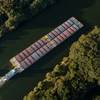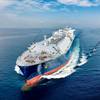Pick Your Power
The inherent diversity of the multitude of vessels plying rivers, lakes, harbors and oceans around the world extends past size and shape and type of service - at the heart of each vessel is a propulsion system. Although propulsion systems may often be considered unique, a variety of typical solutions for most types of vessels already exist. In some cases, it may be preferable to simply specify the duplication of an existing propulsion system, allowing a degree of harmonization in the number of required spares, trained mechanics, and maintenance. It would seem, however, that ship owners and operators are placing an increased premium on designs and solutions both unique and innovative, in order to reduce costs and maximize performance.
The modern emphasis on performance, including speed, maneuverability, efficiency and more recently on emissions, has stimulated the production of a wide variety of different technologies and a multitude of choices that has created considerable complexity in the process of selecting both propulsion components and systems.
This introduction and the series of articles to follow is intended to present an overview of all the modern components that make up a marine propulsion system from power creation to power transmission and control. Systems both traditional in nature and cutting-edge will be explored, and a discussion of green technology being designed and developed for the marine industry will be covered as well.
Before looking forward, consider briefly the rich history of marine propulsion. The earliest examples of humans using waterborne craft dates back to the ancient Egyptians nearly 5,000 years ago. Undoubtedly, the earliest form of a prime mover was human power, but the advent of sails increased the practical range and capacity of early ships. Of course these vessels were at the mercy of the wind, sailing best with the prevailing breeze; it was these limitations that lead to the adoption of steam propulsion at the turn of the 19th century. Though steam gave a ship the ability to move at whim, early steam technology was not especially safe, reliable, or efficient. The earliest type of steam propulsion was of the external combustion reciprocating (single expansion) type. The deficiencies of this type of steam engine were partially overcome with the compound steam engine, which was nearly universally accepted for marine propulsion applications. The more efficient steam turbine engine then replaced early reciprocating steam engines, dominating the marine industry for many years until the superior power-weight ratio of the diesel internal combustion engine finally became viable.
Not only have there been advances in prime mover technology but the way power is applied to the water has changed as well. From human powered paddle wheels in ancient China, to sails, to the modern screw propeller, advances continue to be made to improve efficiency and performance.
Marine Propulsion Systems
Since the advent and application of the steam engine and steam turbine, a purely mechanical propulsion system has been the most common method of propelling a vessel. This system generally consists of a prime mover, which converts the chemical energy in fuel into mechanical work, a shaft and typically a gearbox, which transmits torque, and finally a propeller, which converts rotational work into linear thrust. This "conventional propulsion system" (Figure 1) is well proven and has been the mainstay in vessel propulsion for many years, a testament to the system's simplicity, reliability, and relative efficiency. Other primary propulsion systems are:
Combined mechanical systems, an extension of the purely mechanical system in which two or more prime movers are utilized either singularly or together to match varying power demands. (Figure 2) This type of system is most commonly found in modern military applications, utilizing combinations of gas turbines and diesel engines connected through dual-input gearboxes in CODOG (COmbined Diesel Or Gas) or CODAG (COmbined Diesel And Gas) arrangements. Several other combined mechanical systems exist, including COGAS (COmbined Gas And Steam).
Electric propulsion systems, in which the prime mover turns an electric generator, which supplies electric power to a motor that turns the propeller. (Figure 3) Though less efficient at converting chemical energy into linear thrust than a purely mechanical system, an electric propulsion system provides a large degree of flexibility in matching power generation to varying loads, providing good overall fuel economy. This system offers several additional advantages, including flexibility in locating the prime movers, and high torque capability at low shaft speed. The elimination of long shaft runs simplifies equipment isolation, preventing structural borne noise from being transmitted into the hull. Finally, gearboxes and clutches are typically not required in an electric propulsion system, saving weight, space, and cost.
Parallel hybrid systems, a combination of the best features of mechanical and electric propulsion. Often designed to take advantage of the efficiency of a mechanical system for and the flexibility of an electric system, a parallel hybrid may also incorporate advanced battery technology to store combustion energy, allowing a vessel to operate for limited periods of time with zero emissions running on battery power alone. (Figure 4)
Prime Movers
The most common prime mover in the marine industry today is the diesel engine. Invented by Rudolf Diesel and patented in 1892, the modern marine diesel engine is available in power ranges from 10 BHP to 115,000 BHP to suit nearly every application. Relative to other combustion engines, diesel engines are very efficient in the conversion of chemical energy into mechanical work, in part due to the high compression ratio of the engine as well as the higher energy content of the fuel used. A diesel engine also has fewer frictional losses in the air intake and a more precise injection system than a gasoline engine.
Gasoline and natural gas fuels are also used for marine applications. Because of its lower energy content and volatility, gasoline is rarely used in commercial propulsion applications. However, gasoline is a popular fuel for small recreational craft.
Natural gas is already well established among LNG tankers traditionally designed to burn boil-off gas in a steam propulsion plant. However, the advent of the dual fuel reciprocating engine has offered several advantages to LNG carriers, including a significant reduction in the size of the propulsion plant and flexibility in choosing which fuel to burn based on market conditions. Natural gas is additionally being adopted as a marine fuel for PSVs and ferries where the reduced emissions of a natural gas engine are desired.
Gas turbines, burning nearly any type of mildly refined fuel, are also found in marine propulsion applications. The large initial cost, high fuel consumption, and requirement for large reduction gears has restricted their use to mostly military applications. However, the power-to-weight ratio of a gas turbine cannot be matched by any other non-nuclear prime mover.
Shafting, Gear Boxes, and Electrical Transmission Equipment
Methods of transmitting the rotational work generated by the prime mover to the propulsor have not changed substantially in the last 100 years. Steel is still the most common shaft material, line bearings support the weight of the shaft and maintain alignment, and a thrust bearing transmits propeller thrust into the hull structure. Of the advances that have been made in marine shafting, the integration of composites is perhaps the most significant. Carbon fiber composite shafts are substantially lighter than their steel equivalents, which also allows for the elimination of line bearing - which saves additional weight and cost.
While shafting is responsible for transmitting torque in a purely mechanical propulsion system, an electric propulsion solution requires a system of converters, transformers, drives, and electric cables to transmit power from the generator to the electric drive motor. Although there is flexibility in routing the cable, the designer must still be aware of arrangement limitations, space requirements, and factors which determine the most suitable generating voltage.
In most conventional installations that do not utilize a direct reversing slow-speed prime mover, a gearbox is required to lower rotational speed, increase torque, and provide reversing capability. The sizes of available gearboxes match the substantial range of prime movers - from medium-speed diesel engines to gas turbines. Gearbox arrangement varies widely as well, such as those with dual input capability, down-angle output, or offset output. In some cases, such as a Z-drive, the gearbox is integral to the propulsor.
Propulsors
When in drydock, the most visible part of a vessel's propulsion system is the propulsor - perhaps a conventionally shafted propeller, Z -drive, cycloidal propeller, or waterjet.
Conventionally shafted propulsion systems terminate in a screw propeller, of either the fixed pitch (FP) or controllable pitch (CP) variety. The rotational motion of the screw is translated into linear thrust; the pitch controls the magnitude and direction of this thrust. A fixed pitch propeller must use a reversing gearbox or reversing prime mover in order to make sternway, while the controllable pitch propeller simply reverses pitch. Fixed pitch propellers are most efficient at one speed and therefore ideal for long voyages at constant speed. They also have the advantage of simplicity that translates into low initial and maintenance costs. Controllable pitch propellers, as their name suggests, are capable of varying propeller pitch to match a given load resulting in better power utilization over a range of speeds. With controllable pitch systems, reduced fuel and maintenance costs can be realized by running the main engine at a constant speed. In this configuration, an engine driven electric generator is installed to absorb excess energy from the engine to provide auxiliary power. However, this operational flexibility comes at a much higher initial cost, plus considerable complexity in the pitch control system.
A conventionally shafted propulsion system must also include a rudder in order to change the direction of thrust, allowing the vessel to maneuver. Historically, rudders were little more than flat plates hinged at the leading edge. This simple configuration worked well for small boats, but the unbalanced nature of the rudder induced large, undesirable steering loads in bigger vessels. Balancing the rudder — that is, shifting the axis of rotation aft to about 1/3 of the chord length from the leading edge, minimizes steering loads. Modern rudders come in a variety of shapes and types to match virtually any application, including high-lift shapes for large slow-speed vessels, low-drag shapes for high-speed applications, and articulating or flapper rudders for extreme maneuverability.
Z- and L-drive propulsors, also commonly called azimuthing drives, also make use of screw propellers, typically fixed pitch. However, unlike the conventionally shafted system that requires a reversing gearbox or reversing prime mover to provide thrust aft, an azimuthing drive can spin 360 degrees about its vertical axis to provide full thrust in any direction, also eliminating the need for a rudder. These drives can deliver superior power and maneuverability in a variety of applications. "Z" and "L" drive refer loosely to the power transmission path of each type of drive. The input shaft of a Z-drive is parallel to the propeller shaft, turning in a right-angle gearbox to head down, then turning again in a right-angle gearbox, to drive the propeller shaft. This compact arrangement allows for either a conventional mechanical or electric motor propulsion solution. For electric propulsion, the L-drive eliminates the upper right-angle gearbox, instead an electric motor is arranged inline with the vertically oriented input axis of the drive. Elimination of the upper gearbox improves the mechanical efficiency of the L-drive, but requires greater overhead height in way of the drive unit when compared to the Z-drive installation. When a vessel installs three or more Z or L-drive propulsors, it is not uncommon for the inboard drive(s) to be of the fixed type, solely providing thrust forward and aft. The elimination of the azimuthing mechanism on the inboard drive(s) saves cost, weight, and eases maintenance.
A podded drive is a special type of azimuthing drive that integrates the electric propulsion motor and the propeller on the same shaft in an enclosure outside the hull. This eliminates the need for a gearbox completely, improving mechanical efficiency, as well as freeing up space inside the hull. The combination of arrangement flexibility and high mechanical efficiency, in addition to exceptional maneuverability characteristics resulted in the wide adoption of podded drives for both cruise ships and ice breaking vessels.
Although azimuthing drives can deliver excellent maneuvering characteristics, cycloidal propellers are generally considered superior in maneuvering performance due the near immediate response of the propulsor. A cycloidal propeller consists of a set of blades in a circular arrangement that project down from the bottom of the hull. (Figure 5) The blades rotate about the axis of the array, but are also free to rotate about their own axis. By changing the pitch of the blade as it rotates around the array, thrust can be generated in any direction, with changes in the direction capable of being accomplished almost instantaneously.
Cycloidal propeller units have found wide acceptance among harbor tugs and ferry boats where this extreme maneuverability is highly desirable.
Waterjet propulsion is a third type of propulsor that offers excellent maneuverability and good speed potential, well suited to high-speed, lightweight vessels.
Waterjets are also commonly installed in vessels that have severe draft limitations — with the exception of nozzle and steering gear protruding from the transom, the entire propulsor is contained within the hull. This installation arrangement also provides some protection against grounding damage to the propulsor.
Nozzles are an available option for the propellers of conventionally shafted and azimuthing propulsions systems. In this configuration, the vessel is said to have a "ducted" propeller. Nozzles are generally fitted to vessels that experience high propeller loading at slow vessel speeds, such as tugboats and anchor-handling vessels.
The hydrodynamic interaction between the propeller and the nozzle increases efficiency and thrust at low speed. For any system including a fixed pitch propeller, there is only one speed or load that matches the propeller pitch. A nozzle extends the "near match" over a larger range, resulting in better engine or sometimes eliminating the need for controllable pitch.
As vessel speed increases beyond 10 knots, the benefits of a ducted propeller become marginal due to the excessive drag of the nozzle.
The maneuverability of a vessel, whether driven by azimuthing drives, or conventionally shafted propeller(s), is often augmented by the installation of auxiliary thrusters — commonly found in the bow, but occasionally found in the stern, as well. Fixed transverse tunnel thrusters are often used for this purpose, but azimuthing retractable and swing-up thrusters are also used, particularly where dynamic positioning redundancy is desired. Azimuthing auxiliary thrusters can also offer a source of "get home" propulsion should the main drives be inoperable.
Future Tech/
Green Propulsion Systems
Though virtually all of the propulsion systems and components presented thus far are proven and have been widely adapted throughout the industry, some may not be the best choice given today's reality of rising fuel prices, stricter environmental standards, and earth-friendly "green" focus.
Today's shipowner can expect change tomorrow. The United States Environmental Protection Agency (EPA) has just introduced a new rule that implements Tier 4 NOx requirements two years earlier than previously proposed, and additionally creates unprecedented emissions standards for remanufactured diesel engines. The EPA rule will require the use of a certified remanufacture "kit" if one is available at the time of remanufacture. To obtain certification, the remanufacture kit must be capable of reducing particulate matter emissions by at least 25%. Another potential source of emissions regulations at the state level could come from California's intent to enforce the use of lower-sulfur fuels of vessels within 24 nautical miles of it's coastline. These and other pending regulations demonstrate that vessels of all types and sizes are clearly being targeted as one of the largest sources of airborne emissions, without due regard for the overall efficiencies of the industry, creating considerable challenges for owners, operators and designers.
Innovation will prevail in this new era. Innovation by propulsion suppliers, and innovation by naval architects - each with a part to play. Already suppliers are working on increasing the fuel efficiency of their diesel engines while meeting stringent emissions standards. Propulsor vendors are tweaking their products to obtain maximum efficiency. Some ideas both old and new are being brought to the table - nuclear power, sail power, battery-assisted hybrids, coatings, fuel cells, and alternative fuels. The naval architect is working to obtain the best overall efficiency from the technology that is available today, such as hull form optimization and careful selection of a propulsion system that matches the operational profile of a vessel. The naval architect is also anticipating the new technology yet to come.
Conclusion
Fluidity and strength are two of the characteristics which best describe the current state of the marine industry. As a result of this vitality, demand for a wide variety of new vessels is high, while the availability of building slots, prime movers, and propulsors is strained. These challenges only add to the complexity associated with designing a vessel from the keel up.
A propulsion system well matched to a vessel's intended service is no accident. For the vessel owner or operator who demands more, there is no question in the value of retaining the services of designers well-versed not only in current propulsion technology and how best to apply it, but also fully engaged with the technology of tomorrow.
In articles to follow, we will explore in depth the currently available propulsion system components including prime movers, shafting and gearboxes, and propulsors. We will discuss advantages and disadvantages, applications, and more. There will also be an in-depth look at the technology and components that will define the green generation of marine propulsion.
References:
Davey, Alan. "Moving the LNG Fleet Forward." Surveyor. Spring 2006. 2-5.
Hackman, Thomas, et al. "Podded Propulsion Takes Hold." Surveyor. Summer 2003. 2-6.
Robinson, Dwight. "Understanding Cycloidal Propulsion." <http://www.fishermanlife.com/Mariner/2001/Mar/understand.htm>
"Rudolf Diesel." Speed Ace. http://www.speedace.info/diesel.htm>
Sortland, Simon. "Hybrid propulsion system for anchor handling tug supply vessels." Wartsila Technical Journal. January 2008. 45-48
(Reprinted from the September edition of Maritime Reporter)










